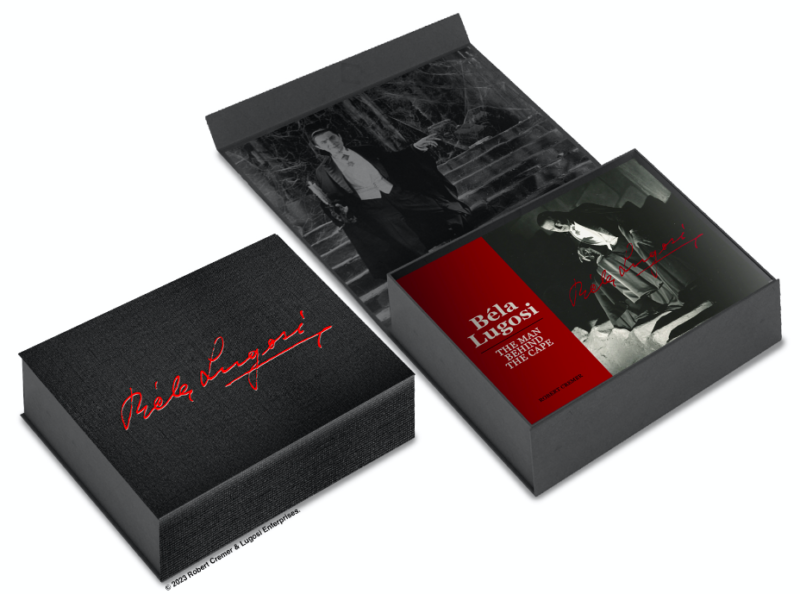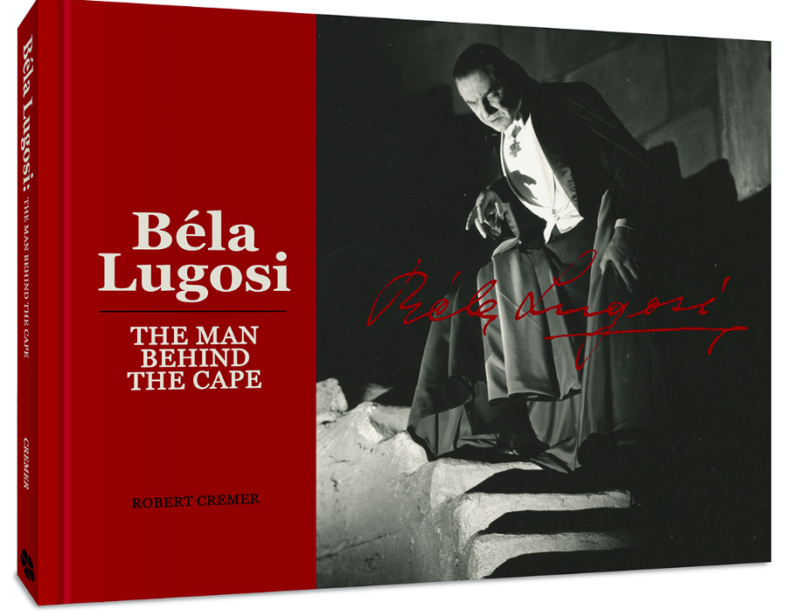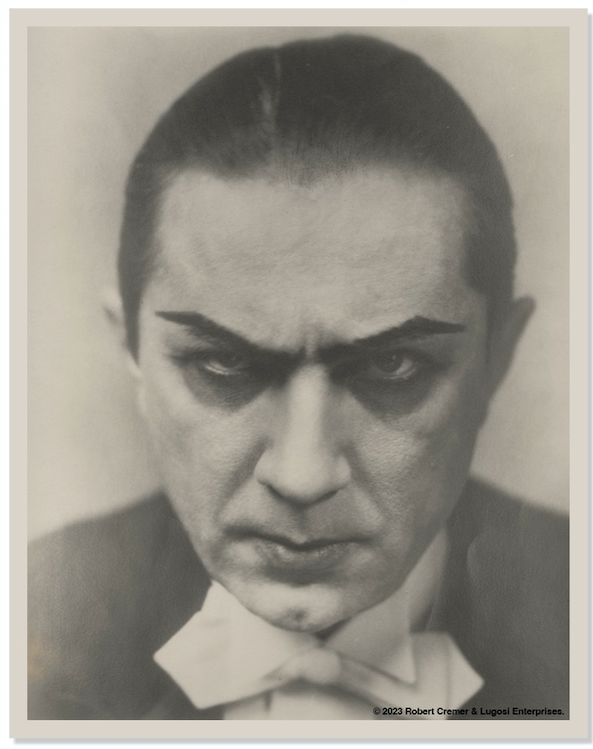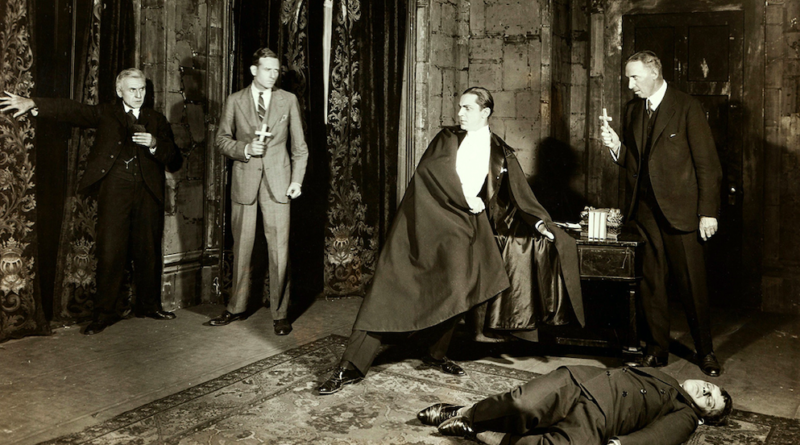INTERVIEW: Béla Lugosi is subject of new book ‘The Man Behind the Cape’
Photo: Béla Lugosi appears in Dracula on Broadway in 1927. Photo courtesy of Robert Cremer & Lugosi Enterprises / Provided by Superfan Promotions with permission.
This time of year, when the jack-o-lanterns are glowing and the cobwebs are decorating the interior of houses, the name Béla Lugosi is heard often in the cultural hubbub. He’s the man who first brought Dracula to life on the silver screen, and his many interpretations of the character continue to play on TV and streaming networks, further cementing his legacy as a horror legend. Additionally, he was a frequent presence in many Hollywood roles over the years, including everything from The Body Snatcher to The Ghost of Frankenstein to The Black Cat.
Now, Robert Cremer is trying to better understand the Lugosi legacy with the new book Béla Lugosi: The Man Behind the Cape, a biography that combines the actor’s real-life story with more than 700 photographs. The images have rarely been seen outside of the Lugosi family. Cremer gained access to them thanks to Lynne Lugosi Sparks, Béla’s granddaughter who curates the Lugosi Family Archives and is CEO of Lugosi Enterprises.
Right now, fans can order the Clover Press book through a Kickstarter campaign that has already amassed $57,000, far exceeding its $10,000 goal. Fundraising continues into mid-November.
Cremer recently exchanged emails with Hollywood Soapbox about the project. He’s a lifelong journalist whose work has been seen in The Hollywood Reporter and San Francisco Chronicle, among many other publications. He currently lives in Germany, where he moved 30 years ago. Questions and answers have been slightly edited for style.

How did the idea come to you to tell Béla Lugosi’s story?
When I was working as a syndicated columnist for The Hollywood Reporter, I renewed my childhood interest in Béla at the Margaret Herrick Library in my spare time. What struck me immediately was the amount of contradictory information that appeared in various newspaper and magazine accounts of his life. In one article, I learned that Béla’s son was a practicing attorney in Los Angeles. That sealed my fate as his biographer. I contacted Bela, Jr. immediately, and we met for lunch to discuss the possibility of a collaboration on a biography of his father. I told him that I truly believed that only a family-authorized biography could correct all the misinformation floating around because only Béla’s family and closest friends knew the facts from their insider relationships with Béla and their personal involvement in his life.
He arranged a meeting for me with his mother, Lillian Lugosi Donlevy, who was married to Béla for 20 years. Béla, Jr. told me, “If she agrees to do it with you, Bob, we do it.” Lillian and I discussed the approach for the book, including clearing the air about Béla’s dependence on drugs and alcohol, and she said, “Bob, I want to set the record straight, especially about the exaggeration of the number of years of his drug dependence. I want the truth told. Béla deserves that, and so does the Lugosi family. Let’s do it.”
Did you have free reign to tell his story — the good and the bad?
Yes. This was Lillian’s explicit wish, and the family supported my research and interviews in every respect without reservation. We arranged interviews with Dr. Nicholas Langer, for example, who was his attending physician during his rehabilitation at Metropolitan State Hospital in Norwalk, California. Both his interviews and information from the hospital records on Béla’s treatment have been included in the biography without alteration. Extensive, exclusive interviews with Edward D. Wood, Jr. also appear in the book, although family members do not necessarily agree with all of his statements. This is, in the truest sense of the word, a no-holds-barred depiction of Béla’s life, including his weaknesses and strengths, and differing viewpoints about certain issues.
How instrumental was it to work with the Lugosi family and have access to archives/pictures?
Béla was a very private individual. He avoided Hollywood events as much as possible and did not hobnob in celebrity circles in Hollywood. He preferred intimate parties with his relatives and closest Hungarian friends. I would not have written the book without them because my goal was to accurately portray this private man in all of his complexity and to correct misinformation that had been promulgated by the press for a very long time. Only with their cooperation, many of whom also knew Béla well in Budapest, could I present the depth of information required to bring the man behind the cape to life.
The Lugosi Family Archives, curated by Béla’s granddaughter Lynne Lugosi Sparks, who is also CEO of Lugosi Enterprises, was indispensable in illustrating events in the biography with documents, correspondence and photos. Béla’s life story becomes a veritable storybook, profusely illustrated with rare family photos, poetry Béla wrote while on the provincial theater circuit in Transylvania, original artwork by noted artists and revealing correspondence concerning major developments in his career.
The composite of Béla’s life that emerges from the unconditional cooperation of the Lugosi family offers the reader a “deep dive” into Béla’s private life and unexpected insights into decisions he made at critical junctures in his professional career. I would say quite honestly that this is an authoritative biography of Béla Lugosi, if not the definitive biography.
When was the first time you saw a Lugosi movie?
My first viewing of a Lugosi film was Dracula in 1957, when Universal Studios released its classic horror film package to TV as Shock Theater. I was immediately fascinated by him and continued watching the classic horror films in order to see him in other roles. I watched him portray the roguish but completely sympathetic Ygor in the Son of Frankenstein and the Gypsy fortuneteller Béla in The Wolf Man, among others. I quickly sensed that his characterizations were so varied and unique that his technique was nothing he could have learned from Lee Strasberg’s method acting. There was something very personal about his portrayals.
What is it about his portrayal of Dracula that works so well?
The elements of his seminal portrayal of Count Dracula were varied, and they have set a very high bar for others essaying the role later. These formative elements begin with his childhood in Transylvania, where he became well acquainted with superstitions surrounding vampires, even though neither he nor his family believed in such things.
Speaking as his biographer now, and not as an avid fan (which I also am!), I am convinced, after uncovering so much information about the details of his personal life, that his life story was, in fact, the negative from which he developed his unique characterizations on stage and film. His life was even dramatic enough to double as another sequel in the Indiana Jones film series. Here are a few examples from his story that illustrate this point:
1. Béla enlisted in the army out of patriotism, although actors were exempt from military service. He suffered wounds that later forced him to take painkillers to ensure that “the show went on” and he did not disappoint his audiences with interruptions or cancellations of performances.
2. His union activism in order to right injustices against actors forced him into exile and resulted in the loss of his first wife, family, country — and almost his life.
3. Two sailors and a cat named Zichy saved Béla’s life during his transatlantic crossing to the U.S. because he was mistakenly determined to be a Bolshevist by the ship’s Hungarian captain.
4. Béla’s dramatic struggle with drugs unfolded in the 1940s, after major Hollywood studios had abandoned him. Rather than give up, he fought back in his 60s with a physically punishing, cross-country barnstorming tour. The resulting struggle with drugs is told by those close to him, who lived through this struggle with him.
If there is any doubt about the formative role his experiences in life played in his stage and film characterizations, one need only look at the opening scene in the Ed Wood film Bride of the Monster. Béla delivers a monologue that mirrored his own experiences as an exiled actor. In the film, he is encouraged to return to his home out of exile. He responds, “Home? I have no home! Hunted and despised …” In 1921, the government in Hungary offered amnesty to those who fled into exile. Béla never again set foot on Hungarian soil.
By John Soltes / Publisher / John@HollywoodSoapbox.com
Béla Lugosi: The Man Behind the Cape, written by Robert Cremer, is currently being fundraised via Kickstarter. Click here for more information.



